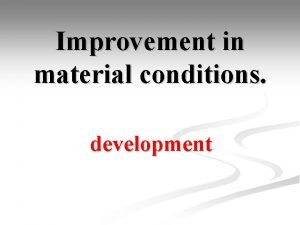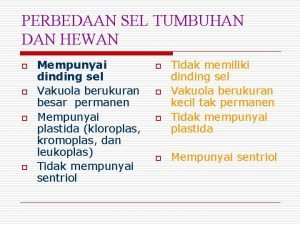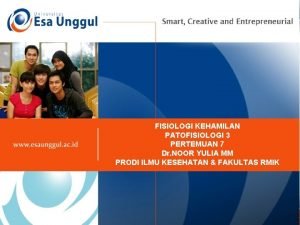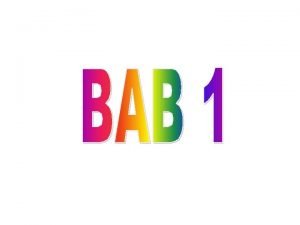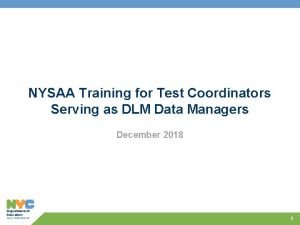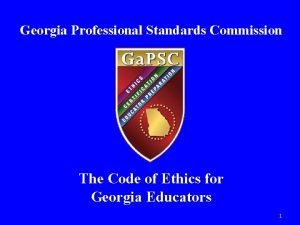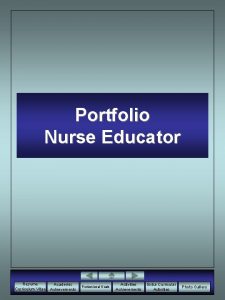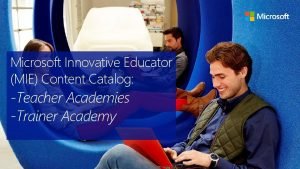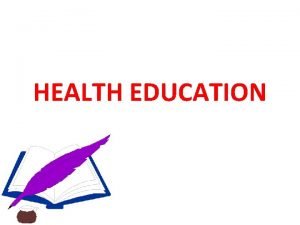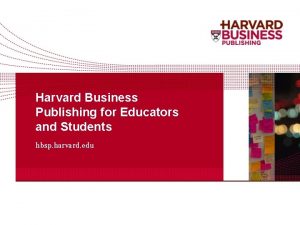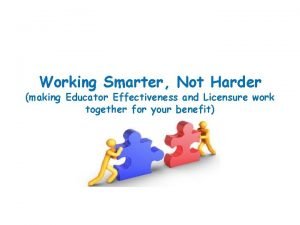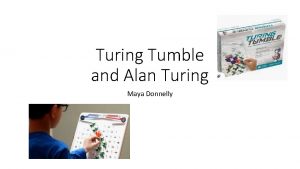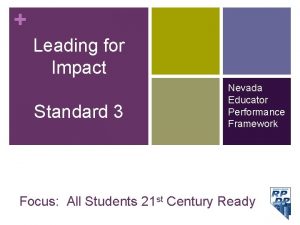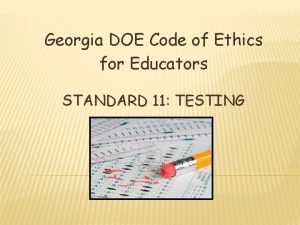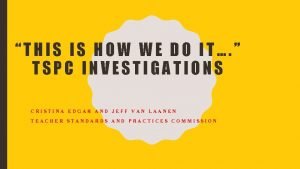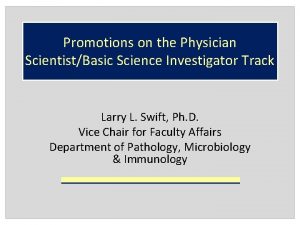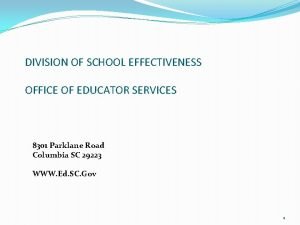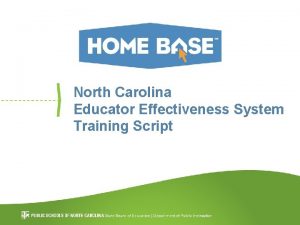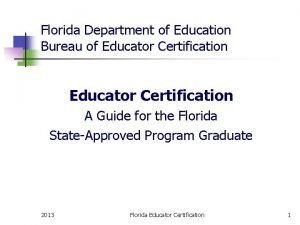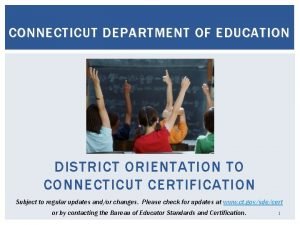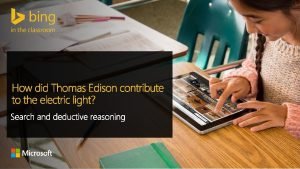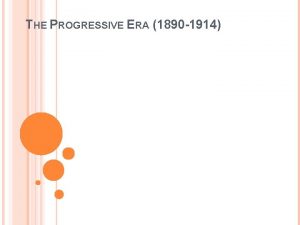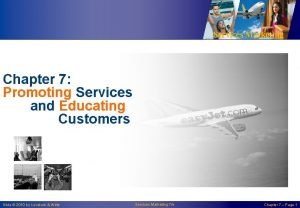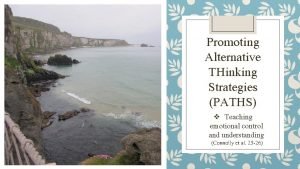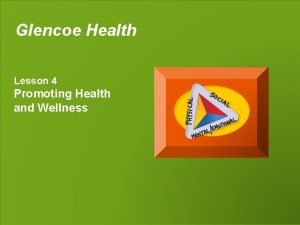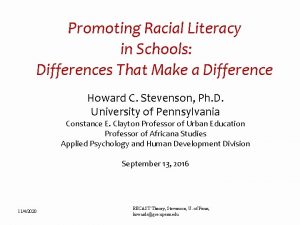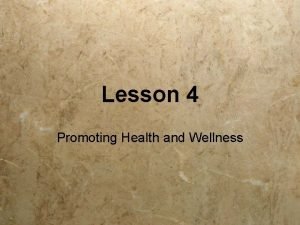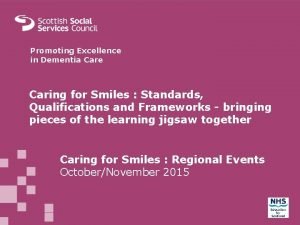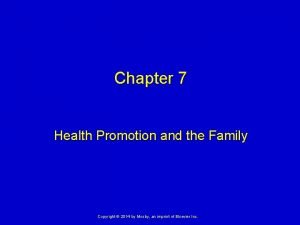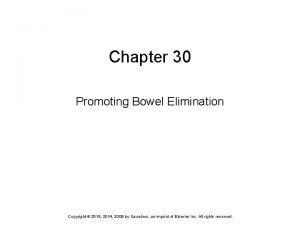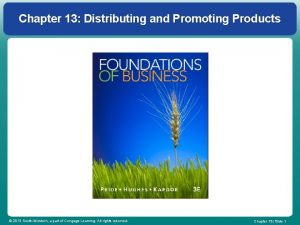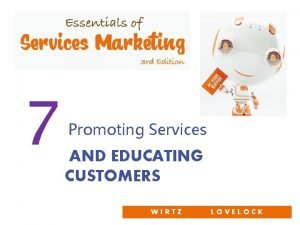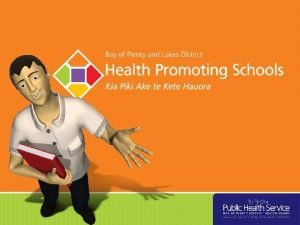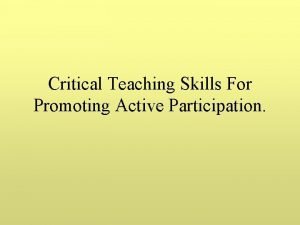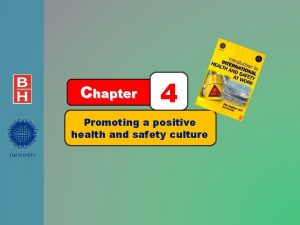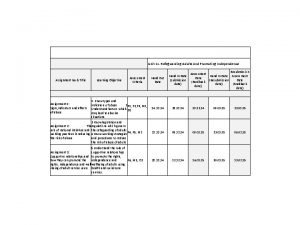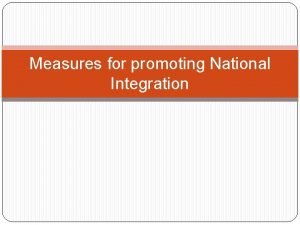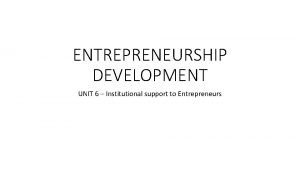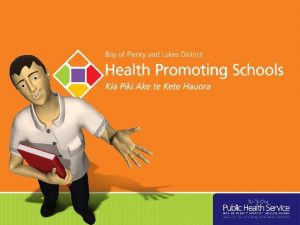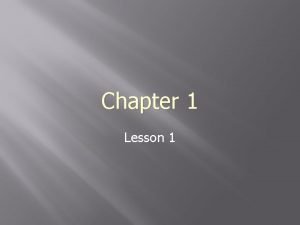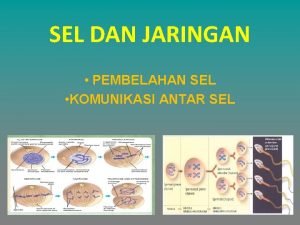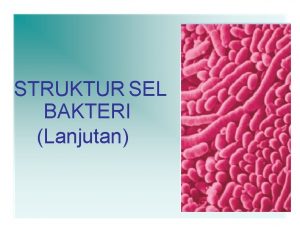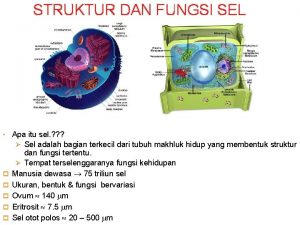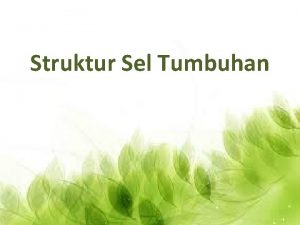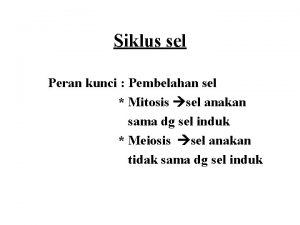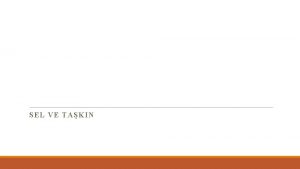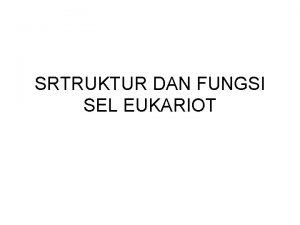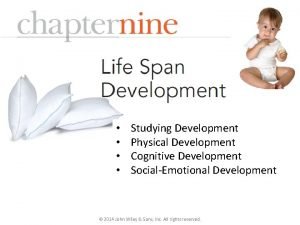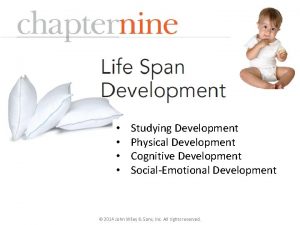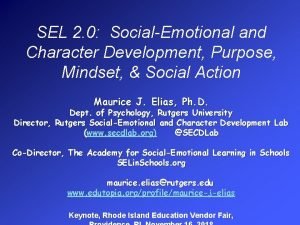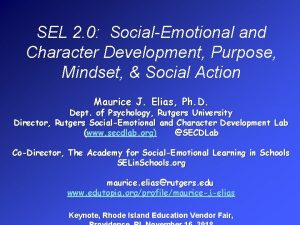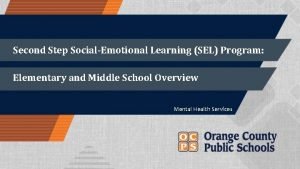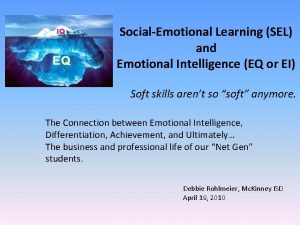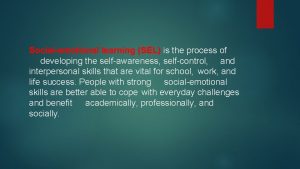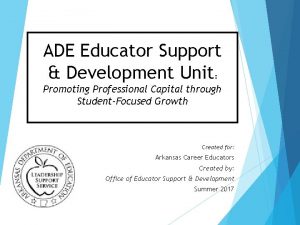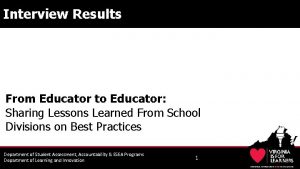SEL for Educator s PROMOTING THE SOCIALEMOTIONAL DEVELOPMENT





















































































- Slides: 85

SEL for Educator s PROMOTING THE SOCIALEMOTIONAL DEVELOPMENT AND WELL-BEING OF ADULTS IN SCHOOL SETTINGS All content is licensed under a Creative Commons Attribution-Non. Commercial-Share. Alike 4. 0 International License.

The SEL for Educators Toolkit consists of this Professional Learning Presentation, a Companion Guide, a Snapshot, and a Reference List. It is intended to be an accessible and actionable synthesis of the research on the social-emotional learning (SEL) of adults in school settings. It is designed to be flexible and adaptable; educators can review and use these tools in their entirety, or select one or more focus areas. It is not intended to be exhaustive, but rather a starting point on the what, the why, and the how of supporting educators' SEL. Due to the wealth of resources focused on system-level support, this toolkit focuses on what educators can do to support their individual growth. Copyright © 2020 Transforming Education 2

A Call To Action For Leaders In addition to utilizing the following strategies, leaders $10, 000 Minimum Investment also have the ability—and obligation—to 30% Equity implement structures and create 20% to Returns Annually support the socialsystems further emotional development and wellbeing of their staff. Copyright © 2020 Transforming Education 3

SYSTEM-LEVEL CONSIDERATIO NS From. Lear CASEL n More Copyright © 2020 Transforming Education Support staff in reflecting on their own social and emotional competencies, identities, and biases. Embed practices that support competencies into district- and school-level staff meetings. Provide frequent opportunities for adults to practice, model, and enhance competencies, including consistent and scaffolded professional learning experiences. Weave competencies through all resources and tools that guide staff in interactions with students, families, and community members. 4

Adult social-emotional development is most successful when there is a strong container that supports individual reflection, examination, learning, and growth. Without a supportive environment and strong system, the individual cannot take on this work. Without the individual work, the structure may be strong, but empty. It is therefore the combination of supportive structures and systems, along with strategies applied at an individual level, that provides the conditions for true adult development in schools. Copyright © 2020 Transforming Education 5

The end goal, of course, is not just to retain warm adult bodies in classrooms, but to meet the needs of our students. Kids need passionate, effective, committed educators. In order to retain such people, school leaders need to provide teachers with resources to meet the challenges they’ll encounter in their work so that they can learn from those challenges, surmount them, and fulfill their purpose. ELENA AGUILAR Copyright © 2020 Transforming Education 6

Overvie w The What Defining Educator SEL Copyright © 2020 Transforming Education The Why Supporting Evidence The How High-Leverage Practices 7

The What Defining Educator SEL “These aren't kid skills. These are human skills. ” Teacher Copyright © 2020 Transforming Education - Classroom 8

Related Terms SEL shares some similarities with terms such as: • Emotional Intelligence • Well-Being • Resilience • Self-Care However, the specific components of SEL for educators in school settings are unique. Lear n Mor e THE WHAT Copyright © 2020 Transforming Education 9

Educator SEL Defined • The competencies that adults need in order to manage stress and create a safe and supportive classroom environment • The skills and mindsets that adults need to effectively embody, teach, model, and coach student SEL. • The overall well-being and emotional state of adults in school settings THE WHAT Copyright © 2020 Transforming Education 10

PROCES How often is SEL discussed in your day-to-day. Swork as it relates to students? PAUSE How often is SEL discussed in your day-to-day work as it relates to adults? On a scale of 1 -10 (1 being least how critical do you think the elements described in the Educator SEL definition are to your role as an educator? Why? important and 10 being most important) THE WHAT Copyright © 2020 Transforming Education 11

The Why Supporting Evidence “The time has come for all schools to address the missing link in what will help educators thrive—a greater focus on all adults’ health and well-being. If we want our educators to be successful—both personally and professionally—schools must be places that bring out the best in them. ” - Marc Brackett & Christina Cipriano Copyright © 2020 Transforming Education 12

Evidence ● Cultivate Strong Relationships ● Model Social-Emotional Skills ● Manage Stress & Reduce Burnout THE WHY Copyright © 2020 Transforming Education 13

Strong Relationships Educators who embody socialemotional skills and mindsets cultivate strong relationships with both colleagues and students. THE WHY Copyright © 2020 Transforming Education 14

Strong relationships within a school community contribute to a positive climate for both students and staff. Lear n Mor e THE WHY Copyright © 2020 Transforming Education 15

Social-Emotional Skills Educators who practice socialemotional skills are able to more effectively model healthy strategies for their students, including how to navigate stress and frustration. THE WHY Copyright © 2020 Transforming Education 16

Teachers who are able to model healthy social-emotional skills contribute to a safe and prosocial learning environment. Lear n Mor e THE WHY Copyright © 2020 Transforming Education 17

Stress & Burnout Educators who develop their socialemotional skills are better able to manage their stress and anxiety, reduce burnout, and are less likely to consider leaving the profession. THE WHY Copyright © 2020 Transforming Education 18

Reducing staff stress levels improves job satisfaction and retention, ensuring that students experience stability and consistency from year to Lear year. n Mor e THE WHY Copyright © 2020 Transforming Education 19

Students with teachers who exhibit lower levels of stress achieve higher test scores and fewer behavior infractions. Lear n Mor e THE WHY Copyright © 2020 Transforming Education 20

PROCESS PAUSE In what context do you see your own social-emotional development most directly impacting students? Which of the aforementioned reasons would motivate you most to focus on your own socialemotional development and wellbeing? Why? Copyright © 2020 Transforming Education THE WHY 21

The How High-Leverage Practices “In order to do the work, we have to do our work. ” - Brené Brown Copyright © 2020 Transforming Education 22

The strategies outlined in the following section focus on work at the individual level. Although this work is ideally done in community, the focus is on change through individual understanding and actions, or areas that are within one’s “Circle of Control. ” If you are a school leader, your position comes with additional responsibility: In addition to your own social-emotional development, you must also consider the ways in which systems and structures encourage or inhibit the social-emotional development of adults in your school. Copyright © 2020 Transforming Education outside your control within your influence within your control THE HOW 23

“We can’t teach what we don’t know. We can’t lead where we won’t go. ” MALCOLM X Copyright © 2020 Transforming Education THE HOW 24

Establish Balance & Boundaries Orient Towards Optimism Examine Identity Educator SEL Explore Emotions Cultivate Compassionat e Curiosity Five High-Leverage Copyright © 2020 Transforming Education 25

Examine Identity Teaching and working in schools is inherently personal work. In order to best serve students, adults must go inward to examine their identities, values, mindsets, and actions. Copyright © 2020 Transforming Education Many educators who remain in the profession struggle to engage with their initial values & purpose. Additionally, educators are not immune to the unconscious biases and stereotyped beliefs that are pervasive in society. By regularly examining the ways in which identities, values, and mindsets influence actions, educators can more effectively serve their students. 26

Examine Identity Define Values & Pursue Purpose • Investigate Privilege & Power • Uncover Bias • Reflect on Work Style • “Good teaching cannot be reduced to technique; good teaching comes from the identity and integrity of the teacher. ” – Parker Palmer 1 Copyright © 2020 Transforming Education 27

Define Values & Pursue Purpose People who are resilient have a clear sense of purpose. Clarity of purpose supports educators in working through challenging situations. Educators with clear values direct their work towards their intended purpose, are able to identify the obstacles that inhibit their ability to pursue their purpose, and can find solutions to those obstacles. 1 Copyright © 2020 Transforming Education 28

ACTIVELY ENGAGE Reflect on your professional purpose and passion through the “What’s Your Why? ” exercise in the Companion Guide. Read Teachers Don’t Need to Find Their Why by Paul Murphy and reflect using the “Pursuing Purpose” prompts in the Companion Guide. Complete the “Defining Values” activity in the Companion Guide to elevate what matters most for you. Try the Passion Profiles Activity to identify your passion and the motivations of colleagues. Engage in the Creating Metaphors Activity to reflect on your identity and integrity as an educator. Reflect using the Gap Analysis Protocol to make a 1 stronger connection between beliefs and Copyright © 2020 Transforming Education practices. 29

Investigate Privilege & Power Privilege is defined as a special right, advantage, or immunity available to a particular person or group, and having privilege conveys power. Both privilege and power are embedded in interactions and relationships, including those that occur within schools. To create brave and safe spaces in classrooms, organizations, and communities, it is crucial to examine the ways power and privilege impact 1 Copyright © 2020 Transforming Education the systems in which we work. 30

ACTIVELY ENGAGE Watch Michael Yates’ TED Talk and reflect using the prompts in the Companion Guide. Watch this video for a quick and accessible explanation of privilege and this video for a look at systemic racism. Read Unpacking the Invisible Knapsack by Peggy Mc. Intosh. Process using this self-reflection activity or engage others in this group activity. Read Why We Can’t Afford Whitewashed SEL by Dena Simmons, The Lens of Systemic Oppression from the National Equity Project, and/or White Racial Identity and Anti-Racist Education by Sandra M. Lawrence and Beverly Daniel Tatum. Process with others using a text protocol found in the Companion Guide. Listen to the “Power in Schools” series (Episodes 73, 74, 75 & 76) on the Modern Learners podcast. Explore the MSW@USC Diversity Toolkit: A Guide to Discussing Identity, Power and Privilege. 1 Copyright © 2020 Transforming Education 31

Uncover Bias is defined as “a natural inclination for or against an idea, object, group, or individual. It is often learned and is highly dependent on variables like a person's socioeconomic status, race, ethnicity, educational background, etc. ” Bias can occur at the individual, system, and societal level. In school settings, unconscious bias can lead to disparities in how students are treated through discipline policies, academic experiences, and adult expectations. Educators who work to uncover their own bias are more likely to display confidence in and affirm their students. They also set high expectations for all students and 1 support them in reaching their goals. Copyright © 2020 Transforming Education 32

ACTIVELY ENGAGE Watch one of the short videos below and reflect using the prompts in the Companion Guide. ● ● ● Implicit Bias in Education (2: 40) How Unconscious Bias affects judgement (1: 07) PBS’s Implicit Bias: Peanut Butter, Jelly and Racism (2: 26) Bias in American Schools (10: 50) Video series from UCLA (7 videos, each 5 minutes or less) Read Teachers are as Racially Biased as Everyone Else, Study Shows and consider reflecting with a group using a text protocol found in the Companion Guide. Test yourself for hidden bias using the Implicit Bias Test from Project Implicit. Deepen your learning through a PD module on Anti-Bias Education from Teaching Tolerance. Listen to this podcast on Unconscious Bias in Schools from Harvard Ed. Cast (28 min). 1 Copyright © 2020 Transforming Education 33

Reflect on Work Style Reflecting on one’s personality, work style, and leadership approach can support self-awareness and identity development. Those who are self-aware able to capitalize on their strengths and ask for support in their areas of growth. This self-awareness further enables educators to communicate 1 challenges and seek support, which can strengthen team dynamics. Copyright © 2020 Transforming Education 34

ACTIVELY ENGAGE Complete one of the following self-reflection exercises. Then share, discuss, and debrief with those whom you work with closely. ● Compass Points ● 16 Personalities ● Roles in a Social Change Ecosystem ● Daring Leadership Engage in the Qualities of an Educational Leader Exercise to explore your own style as a leader/teacher. Discuss and debrief with others. 1 Copyright © 2020 Transforming Education 35

PROCESS PAUSE • Define Values & Pursue Purpose • Investigate Privilege & Power • Uncover Bias • Reflect on Work Style How do you see your own identity showing up in your work? Of the four strategies outlined here, which do you feel you have done the most work on? Of the four strategies outlined here, which do you feel you need to focus on more? Why? 1 Copyright © 2020 Transforming Education 36

Explore Emotions Emotional awareness involves the way we recognize and make sense of our own emotions, as well as the emotions of others. Educators who explore their own emotions report that they are more effective in classroom management and have stronger relationships with students. Copyright © 2020 Transforming Education 37

Explore Emotions Label Emotions • Recognize Physical Reactions • Respond Rather Than React • “As an educator, we learned how to read and how to do math but we weren’t explicitly taught how to talk about our feelings. ” – Randi Peterson 2 Copyright © 2020 Transforming Education 38

Label Emotions Increasing one’s emotional vocabulary enables educators to more accurately identify and articulate feelings, ensuring that emotional responses are both productive and intentional. By simply naming an emotion, the brain releases neurotransmitters which can calm the neurological stress response, subsequently creating distance between ourselves and our experience. This distance can allow for the time and space to consider how best to respond. 2 Copyright © 2020 Transforming Education 39

ACTIVELY ENGAGE Read this Harvard Business Review article on the power of labeling emotions and try one of the included exercises. Watch Dan Siegel’s video (2: 00) for a simple explanation of the neuroscience of naming emotions. Complete the reflection exercise in the Companion Guide using the Feelings Wheel to consider the multiple layers of an emotion. 2 Copyright © 2020 Transforming Education 40

Recognize Physical Responses We often experience emotions directly in the body. Emotions trigger physical responses such as muscle tension, sweaty palms, or an elevated heart rate. Noticing these physical responses can help identify stressors. When we 2 understand the effects of emotions, we can respond intentionally, rather Copyright © 2020 Transforming Education than merely react. 41

ACTIVELY ENGAGE Complete the reflection exercise in the Companion Guide to consider where and how you feel emotions in the body. Watch this video (2: 00) about mapping emotions in the body. Read about how a body scan practice can help you reduce biological stress and engage in the included guided practice. Guide yourself through a body scan exercise with one of these two resources: ● Search Inside Yourself: The Body Scan ● Stop, Breathe, Think: Body Scan 2 Copyright © 2020 Transforming Education 42

Respond Rather Reactions occur instinctively, without deliberate thought or full consideration of Than React impact. Responses are intentional and deliberate, with awareness of what we are doing, why we are doing it, and how it will impact others. Mindfulness trains one’s mind to respond rather than react. Mindfulness is the practice of intentionally paying attention to one’s thoughts, emotions, and physical sensations, in the present moment and without judgement. Educators who engage in mindfulness show reduced stress and burnout, have greater confidence in their role, cultivate more emotionally supportive relationships, and 2 have better classroom Copyright © 2020 Transforming Education 43

ACTIVELY ENGAGE Read an accessible synthesis of the research on the benefits of mindfulness from Mindful Schools. Read about three simple mindfulness practices from Meena Srinivasan that can be incorporated into the school day. Watch and listen as teachers reflect on their own mindfulness practice and its impact on their work. ● Finding My Breath: Cultivating a More Compassionate Classroom ● Mindfulness in Education: Learning from the Inside Out Engage in a 1 -minute, 5 -minute, or 10 -minute breathing exercise using a simple shape as a visual cue. Learn about and reflect on ways to incorporate grounding practices into your day. Consider using a post-it on your laptop (or some other key spot) with one of the following acronyms as a reminder to take a moment and respond, rather than react: RAIN, STOP, SNACK. Learn about the ways mindfulness can reduce unconscious bias. Read an interview with San Francisco Department of Public Health Program Innovation 2 Leader, Jenée Johnson, to explore the connections between trauma, stress, racial Copyright © 2020 Transforming Education equity, and mindfulness. 44

PROCESS PAUSE • Label Emotions • Recognize Physical Responses • Respond Rather Than React How do you see your emotions enhancing or inhibiting your work with students, staff, and families? Of the three strategies outlined here, which do you feel you have done the most work on? Of the three strategies outlined here, which do you feel you need to focus on more? Why? 2 Copyright © 2020 Transforming Education 45

Cultivate Compassiona te Curiosity Compassionate curiosity involves approaching each interaction as an investigator and exploring why a behavior is happening, with the understanding that behavior is a form of communication. Compassionate curiosity allows one to approach each situation with empathy instead of judgement. Copyright © 2020 Transforming Education 46

Cultivate Compassionate Curiosity Apply an Asset-Based Lens • Listen with Empathy • View Behavior as Communication • “‘Compassionate curiosity’ is medicinal. It is also illuminating. It can interrupt our potential biases and assumptions about our students’ thinking and abilities. ” 3 Copyright © 2020 Transforming Education - Kyle Redford 47

Apply an Asset-Based Research suggests that focusing on Lens another person’s strengths, rather than perceived weaknesses, can lead to better outcomes. In a school setting, when teachers focus on student strengths rather than potential limitations, students are more successful and engaged. Copyright © 2020 Transforming Education Culturally competent educators who view student experiences through an asset-based lens elevate students' voices, provide materials and activities that draw on diverse cultures, capitalize on students’ culturally grounded experiences, and promote 3 equitable conditions for their more 48

ACTIVELY ENGAGE Watch this video (2: 45) and reflect using the prompts in the Companion Guide. Watch Chris Wejr’s TED Talk or Kathy Kramer’s TED Talk and reflect using the prompts in the Companion Guide. Read this quick synopsis on the “what” and “why” of an asset-based approach in schools and reflect using a text protocol found in the Companion Guide. Identify your own strengths (and those of students) through the VIA Character Strengths Survey. 3 Copyright © 2020 Transforming Education 49

Listen with Empathy Empathic listening is a dynamic process that requires the listener to take in more than just the speaker's words. It has been described as listening with one’s ears, eyes, and heart, and it goes beyond active or reflective listening. Listening and responding with empathy helps educators understand, build, and maintain relationships. It contributes to a student’s sense 3 of belonging and enables educators to calibrate support to student Copyright © 2020 Transforming Education 50

ACTIVELY ENGAGE Watch this video (7: 40) and read the corresponding article to further understand the intersection of compassionate curiosity and empathy. Watch Kwame Christian’s TED Talk and reflect using the prompts in the Companion Guide. Utilize the Missed Cues Protocol to consider ways we can unpack assumptions and/or listen more deeply to students. Practice empathic listening by role-playing authentic scenarios related to students, staff, or families. ● Active & Intentional Listening Guidelines ● 7 Ways to Respond to Students with Empathy ● 7 Tips for Empathic Listening ● Handbook for Facilitating Difficult Conversations in the Classroom 3 Copyright © 2020 Transforming Education 51

View Behavior as Communication Viewing behavior as a form of communication allows adults to embrace opportunities to respond to students as whole humans, rather than responding to individual behaviors. When teachers recognize the reason behind behaviors, they can implement preventative strategies, respond with care, and maintain strong relationships with their students. This approach ensures that teachers identify challenging behavior as a symptom of unmet needs that can be addressed through targeted supports, rather than as a sign of willful defiance or disrespect. 3 Copyright © 2020 Transforming Education 52

ACTIVELY ENGAGE Read Understanding Behavior as Communication: A Teacher’s Guide or Behavior is Communication and reflect using a text protocol found in the Companion Guide. Explore the four visual representations of content found in the Companion Guide and reflect using a text protocol. Watch Dear Teacher: Heartfelt Advice for Teachers from Students and reflect using the prompts in the Companion Guide. Read Lens as a Paradigm. Consider the ways in which your lens impacts the way you view student behavior and how you might change your lens or shift your focus. 3 Copyright © 2020 Transforming Education 53

PROCESS What strengths do you feel you bring to your work? What strengths do you see your students bringing? Of the three strategies outlined PAUSE • Apply an Asset-Based Lens • Listen with Empathy • View Behavior as here, which do you feel you have done the most work on? Communication Of the three strategies outlined here, which do you feel you need to focus on more? Why? 3 Copyright © 2020 Transforming Education 54

Orient Towards Optimism Optimistic thinking refers to an individual’s attitude of confidence, hopefulness, and positive thinking regarding themselves and their life situations in the past, present, and future. Optimism is considered a key protective factor in supporting health, joy, amusement, awe, and happiness, while decreasing anxiety & depression. Copyright © 2020 Transforming Education 55

Orient Towards Optimism Recognize Negativity Bias • Reframe & Retrain the Brain • Practice Gratitude • “The brain is like Velcro for negative experiences but Teflon for positive ones. ” 4 Copyright © 2020 Transforming Education - Rick Hanson 56

Recognize Negativity Bias Our brains have a bias towards negativity. We consistently scan for bad news, overreact to it, and commit it to memory. This is a survival mechanism rooted in our evolution. Hypervigilance, a state of increased alertness in response to negative stimuli, produces more neural activity than does equally intense positive stimuli. Adults who are aware of their own negativity bias are more able to counteract it by elevating moments of positivity and joy for themselves as well as for their students, colleagues, and families. 4 Copyright © 2020 Transforming Education 57

ACTIVELY ENGAGE Watch this short video (2: 00) or this slightly more in-depth video (6: 00) to understand negativity bias. Read this blog post about negativity bias and strategies for getting past it. Consider the way Kindness Practices can combat negativity bias. 4 Copyright © 2020 Transforming Education 58

Reframe & Retrain the By directing attention to positive experiences and applying specific Brain strategies, one can "retrain" the brain to better detect positivity, thereby committing to memory one’s emotional and physical responses to positive experiences. 4 Copyright © 2020 Transforming Education 59

ACTIVELY ENGAGE Read How to Get Past Negativity Bias in Order to Hardwire Positive Experiences or watch Rick Hanson’s TED Talk on Hardwiring Happiness and try his HEAL approach. Read Changing How Educators See Negative Behaviors and reflect using a text protocol found the Companion Guide. Engage in “The Best Ever” protocol to reflect on a past positive experience. 4 Copyright © 2020 Transforming Education 60

Practice Gratitude is a process or practice that can be both intrapersonal (recognizing positive outcomes one has achieved) or interpersonal (recognizing external sources of positive outcomes). Practicing gratitude can foster physical, psychological, and social benefits. It is associated with increased happiness, strengthened relationships, decreased anxiety and depression, and increased motivation. Gratitude practices are associated with improved sleep, lower blood pressure, and strengthened immune systems. 4 Copyright © 2020 Transforming Education 61

ACTIVELY ENGAGE Read how gratitude changes the brain or how gratitude can get us through hard times. Watch a short video (4: 10) on the connection between gratitude and the science of happiness. Watch Kerry Howells’ TED Talk about gratitude in education and reflect using the prompts in the Companion Guide. Write a gratitude letter, keep a gratitude journal, and/or take a gratitude quiz. 4 Copyright © 2020 Transforming Education 62

PROCESS PAUSE • • • Recognize Negativity Bias Reframe & Retrain the Brain Practice Gratitude Consider the last 24 hours. Can you identify three positive things that happened? Of the three strategies outlined here, which do you feel you have done the most work on? Of the three strategies outlined here, which do you feel you need to focus on more? Why? 4 Copyright © 2020 Transforming Education 63

Establish Balance & Boundaries are the guidelines that we use to set expectations, responsibilities, and limits for ourselves and for other people. Setting professional boundaries protects one’s energy and attention while supporting long-term engagement in one’s work. With educators reporting stress levels on par with nurses and physicians, establishing balance and boundaries is crucial for remaining passionate and effective in one’s work. Copyright © 2020 Transforming Education 64

Establish Balance & Boundaries Understand the "Cost of Caring" • Form Healthy Habits • Ask for Help & Learn to Say “And there’s always this feeling that you could be doing more. . . it burnt No through our emotional resilience and destabilized our emotional constancy • with one another and with students. ” – Henry Seton 5 Copyright © 2020 Transforming Education 65

Understand the "Cost of In addition to their own personal Caring" histories, life events, and emotional experiences, educators are often faced with the "cost of caring" that comes from bearing witness to and supporting students through their own struggles. This cost is known as compassion fatigue, secondary trauma, and vicarious trauma, all of which can lead to burnout. Furthermore, students' experiences are compromised when adults are emotionally depleted in this way. Educators who are aware of the "cost of caring" can explore prevention strategies to reduce their risk and Copyright © 2020 Transforming Education increase their resiliency. 5 66

ACTIVELY ENGAGE Read about the signs and impact of the "cost of caring" and learn about coping strategies: ● NCTSN: Secondary Traumatic Stress Fact Sheet ● ‘I Didn’t Know It Had a Name’: Secondary Traumatic Stress and Educators ● Compassion Fatigue: How California Can Improve Teacher Retention Complete the Professional Quality of Life Self. Assessment. Read When Teachers Experience Empathic Distress and engage in a self-compassion practice. Listen to the podcast episode Demoralized, Not Drained from Harvard Ed. Cast. ** You do not have to address these challenges alone. ** Professional resources are available to support you in this work. Ask your employer or professional association about opportunities, resources, and assistance. 5 Copyright © 2020 Transforming Education 67

Form Healthy Habits Strategies for stress management, selfcare, and physical health are key to educators' effectiveness. Nutrition, exercise, and adequate sleep are foundational to combating the effects of physical, emotional, and mental stress. When educators engage in more healthy behaviors, they cope more effectively and experience less stress. Teachers who are happy and healthy enjoy greater job satisfaction, as well as decreased burnout and professional turnover. 5 Copyright © 2020 Transforming Education 68

ACTIVELY ENGAGE Read about Six Stress Busting Strategies and complete the self-reflection from the California Surgeon General. Read about seven habits of healthy educators, suggestions for fitting in fitness, and ideas about improving your sleep routine. Read Creating Healthy Habits from the National Institute of Health. Try the New York Times’ 28 -day Healthy Habits Well Challenge. 5 Copyright © 2020 Transforming Education 69

Ask for Help & Learn to Say No Overcommitting and overextending can impact one’s ability to pursue purpose and focus on priorities. An inability to say “no” negatively impacts one’s mental health, relationships, and productivity. Most workplace support is provided in direct response to a request for help; therefore, knowing how and when to ask for help, or simply saying no, is essential for advocating for oneself Copyright © 2020 Transforming Education in the workplace. 5 70

ACTIVELY ENGAGE Read It’s OK to Say No and process using a text protocol found in the Companion Guide. Watch Heidi Grant’s TED Talk and reflect using the prompts in the Companion Guide. Connect with colleagues who will engage with you using the Tap In/Tap Out strategy. Read Every Teacher Needs a Mentor and consider seeking out or starting a mentorship program. 5 Copyright © 2020 Transforming Education 71

PROCESS PAUSE • Understand the "Cost of Caring" • Form Healthy Habits • Ask for Help & Learn to Say No When was the last time you asked for help? When was the last time you said no to a request? How did you feel in both of these situations? Of the three strategies outlined here, which do you feel you have done the most work on? Of the three strategies outlined here, which do you feel you need to focus on more? Why? 5 Copyright © 2020 Transforming Education 72

REFLECT CONNECT Of the FIVE HIGHLEVERAGE PRACTICES outlined, with which do you feel most comfortable and confident? Of the FIVE HIGHLEVERAGE PRACTICES outlined, with which do you feel you need the most support? Copyright © 2020 Transforming Education 73

I’ve come to a frightening conclusion that I am the decisive element in the classroom. It’s my personal approach that creates the climate. It’s my daily mood that makes the weather. As a teacher, I possess a tremendous power to make a child’s life miserable or joyous. I can be a tool of torture or an instrument of inspiration. I can humiliate or heal. In all situations, it is my response that decides whether a crisis will be escalated or de-escalated and a child humanized or dehumanized. HAIM GINOTT Copyright © 2020 Transforming Education 74

Appendi x The The What Why How Copyright © 2020 Transforming Education 75

Companion Guide The SEL for Educators Companion Guide provides additional details about the interactive components outlined in the presentation, as well as, suggestions for pacing, application, and further learning. Take a look! Copyright © 2020 Transforming Education 76

System-Level Considerations Report School Leaders’ Role in Empowering Teachers Through SEL Articles Leading Together/SEL for Adults Teachers Are Anxious and Overwhelmed. They Need SEL Now More Than Ever. Tool SEL 3 Signature Practices Playbook Resource Center CASEL’s District Implementation Framework (Focus Area 2): Strengthening Adult SEL Competencies & Capacities Copyright © 2020 Transforming Education BAC K 77

The What • Social and emotional learning, as defined by CASEL, “is the process through which children and adults understand manage emotions, set and achieve positive goals, feel and show empathy for others, establish and maintain positive relationships, and make responsible decisions. ” • Emotional intelligence, as defined by Salovey & Mayer (1990), “is a type of social intelligence that involves the ability to monitor one's own and others' emotions, to discriminate among them, and to use the information to guide one's thinking and actions. ” • Well-being includes peoples' positive evaluations of their lives, and includes positive emotion, engagement, satisfaction, and meaning (Seligman, 2002). • Seligman (2011) has conceptualized well-being through the PERMA framework: � Positive emotions � Engagement � Relationships � Meaning � Accomplishment Copyright © 2020 Transforming Education BAC K 78

The Why Cultivate Strong Relationships • Adults who develop their own social-emotional skills: � enjoy increased trust with colleagues (Bryk & Schneider, 2002); � and cultivate strong relationships with their students (Jennings & Greenberg, 2009). • Strong teacher-student relationships lead to: � fewer behavioral issues with students (Marzano & Marzano, 2003); � and stronger classroom management (Durlak et al. , 2011). Moreover, modeling SEL offers students positive examples of how to maintain healthy relationships (CASEL). Copyright © 2020 Transforming Education BAC K 79

The Why Model Social-Emotional Skills “When a student is in stress, his emotions will echo in the adult. If the adult is not trained to own and to accept his or her counter-aggressive feelings, the adult will act on them and mirror the student’s behavior. This means an aggressive student will always create counteraggressive feelings in the adult. Whenever adults act on these feelings, do what seems normal, and follow their impulses, the situation will become more emotional, irrational, and volatile (Long, 1995). ” Copyright © 2020 Transforming Education • Adults who cultivate their own social-emotional skills are able to teach and model the same skills to students (Jennings & Greenberg, 2009). • Modeling SEL offers students positive examples of how to navigate stress and frustration and improves the overall learning climate (CASEL). • In classrooms where teachers intentionally regulate BAC and reappraise their emotions, students report K 80 lower emotional distress and more prosocial

The Why Manage Stress & Reduce Burnout Stress • 61% of teachers report feeling stressed (AFT/BAT, 2017). • Low teacher stress is associated with higher academic test scores and improved behavior (Herman et al. , 2018). � Teachers are tied with nurses for the highest rate of stress among all occupational groups (Greenberg et al. , 2016). � Elevated stress hormones–including cortisol–are ultimately detrimental to many aspects of physical health (Greenberg et al. , 2016). � Staff absenteeism is lower in schools where teachers can identify and regulate their own emotions (Lever et al. , 2017). Burnout • 58% of teachers report that their mental health is “not good” (AFT/BAT, 2017). • Teachers are less likely to report burnout if they have effective methods for managing stress (Brackett et al. , 2010). • Educators’ overall satisfaction is associated with higher student well-being, including increased prosocial behavior (Braun et al. , 2020). Copyright © 2020 Transforming Education Turnover • In 2018, public school educators left the profession at higher rates than ever before (Hackman & Morath, 2018). • Newer teachers, with less experience, incur heightened BAC training costs for their schools and districts (Greenberg et K al. , 81

The Why Additional Information Adults who cultivate their own social-emotional skills: • improve school climate (Di. Paola & Tschannen-Moran, 2001); • and experience improved performance and satisfaction (Lee, 2017; Mohamad & Jais, 2016). In schools where staff build their emotional intelligence: • change efforts are more likely to be successful and sustainable (Aguilar); • staff, student, and community experiences in school are more stable due to decreased turnover (Greenberg et al. , 2016). BCK Copyright © 2020 Transforming Education 82

The Why Additional Information The Prosocial Classroom Model Copyright © 2020 Transforming Education In the Prosocial Classroom Model, Jennings & Greenberg (2009) theorized that the social-emotional development and well-being of teachers influences many factors of the school experience. The model suggests that teacher SEL impacts teacher-student relationships, classroom management, SEL implementation, classroom climate, and students' outcomes. The authors maintain that school and community contexts 83 impact all aspects of these relationships.

Acknowledgements Thank you to all those who supported in the development of this toolkit including educators, school leaders, members of the New. Schools Invent Team, and our Advisory Board members. We greatly appreciate your thoughtful feedback, guidance, and expertise. The development of this toolkit was supported by New. Schools Venture Fund. This toolkit is informed by an extensive amount of research from the field. All sources used within this toolkit are cited within our Reference List. Copyright © 2020 Transforming Education 84

Contact Access other toolkits or downloadable papers: www. transformingeducation. org Stay up to date: SUBSCRIBE: Newsletter You. Tube FOLLOW: Twitter | @transforming_ed Facebook | @transforminged Instagram | @transformed Linked. In | Transforming Education, Inc Ask us questions or provide feedback: info@transformingeducation. org
 Tabel perbedaan sel tumbuhan dan sel hewan
Tabel perbedaan sel tumbuhan dan sel hewan Japan's principal asset in promoting development is
Japan's principal asset in promoting development is Fungsi sel haiwan
Fungsi sel haiwan Vakuola berukuran besar
Vakuola berukuran besar Reserch gate
Reserch gate Macam macam membran kehamilan
Macam macam membran kehamilan Gambar sel prokariotik
Gambar sel prokariotik Dlm educator portal
Dlm educator portal Duration of micro lesson plan
Duration of micro lesson plan Teachers violating the code of ethics in georgia
Teachers violating the code of ethics in georgia Georgia professional standards
Georgia professional standards Msde educator portal
Msde educator portal Nurse educator resume
Nurse educator resume Microsoft teacher academy
Microsoft teacher academy Health education definition who
Health education definition who Hbsp coursepack
Hbsp coursepack Allied educator primary school
Allied educator primary school Alabama educator code of ethics
Alabama educator code of ethics Slo and ppg examples
Slo and ppg examples Maya donnelly
Maya donnelly Nevada educator performance framework
Nevada educator performance framework Code of ethics for educators georgia
Code of ethics for educators georgia Tspc sanction list
Tspc sanction list Vumc educator portfolio
Vumc educator portfolio Office of educator services
Office of educator services Nc educator effectiveness system
Nc educator effectiveness system Cg-10 application form
Cg-10 application form Connecticut teacher certification reciprocity
Connecticut teacher certification reciprocity Comclassroom
Comclassroom When was the progressive era? *
When was the progressive era? * Promote service arrange decide
Promote service arrange decide Promoting alternative thinking strategies
Promoting alternative thinking strategies Lesson 4 promoting health and wellness
Lesson 4 promoting health and wellness Promoting family earthquake preparedness
Promoting family earthquake preparedness Lesson 4 promoting health and wellness
Lesson 4 promoting health and wellness Promoting racial literacy in schools
Promoting racial literacy in schools Lesson 4 promoting health and wellness
Lesson 4 promoting health and wellness Methods of promoting intrapreneurship leaving cert
Methods of promoting intrapreneurship leaving cert Promoting infant health section 7-2
Promoting infant health section 7-2 Promoting excellence in dementia care
Promoting excellence in dementia care Deontological moral theory
Deontological moral theory Chapter 7 promoting health and wellness
Chapter 7 promoting health and wellness Promoting bowel elimination
Promoting bowel elimination Chapter 13 distributing and promoting products
Chapter 13 distributing and promoting products Promoting services and educating customers
Promoting services and educating customers Health promoting schools model
Health promoting schools model Promoting active participation
Promoting active participation Promoting a positive health and safety culture
Promoting a positive health and safety culture Unit 11 safeguarding adults and promoting independence
Unit 11 safeguarding adults and promoting independence Promoting national integration
Promoting national integration Role of support institutions include
Role of support institutions include Health promoting school
Health promoting school Chapter 1 lesson 4 promoting health and wellness
Chapter 1 lesson 4 promoting health and wellness Fspos
Fspos Typiska drag för en novell
Typiska drag för en novell Tack för att ni lyssnade bild
Tack för att ni lyssnade bild Ekologiskt fotavtryck
Ekologiskt fotavtryck Varför kallas perioden 1918-1939 för mellankrigstiden?
Varför kallas perioden 1918-1939 för mellankrigstiden? En lathund för arbete med kontinuitetshantering
En lathund för arbete med kontinuitetshantering Särskild löneskatt för pensionskostnader
Särskild löneskatt för pensionskostnader Vilotidsbok
Vilotidsbok Anatomi organ reproduksi
Anatomi organ reproduksi Densitet vatten
Densitet vatten Datorkunskap för nybörjare
Datorkunskap för nybörjare Stig kerman
Stig kerman Hur skriver man en tes
Hur skriver man en tes Magnetsjukhus
Magnetsjukhus Nyckelkompetenser för livslångt lärande
Nyckelkompetenser för livslångt lärande Påbyggnader för flakfordon
Påbyggnader för flakfordon Vätsketryck formel
Vätsketryck formel Svenskt ramverk för digital samverkan
Svenskt ramverk för digital samverkan Bo bergman jag fryser om dina händer
Bo bergman jag fryser om dina händer Presentera för publik crossboss
Presentera för publik crossboss Jiddisch
Jiddisch Kanaans land
Kanaans land Klassificeringsstruktur för kommunala verksamheter
Klassificeringsstruktur för kommunala verksamheter Epiteltyper
Epiteltyper Claes martinsson
Claes martinsson Cks
Cks Lågenergihus nyproduktion
Lågenergihus nyproduktion Mat för unga idrottare
Mat för unga idrottare Verktyg för automatisering av utbetalningar
Verktyg för automatisering av utbetalningar Rutin för avvikelsehantering
Rutin för avvikelsehantering Smärtskolan kunskap för livet
Smärtskolan kunskap för livet Ministerstyre för och nackdelar
Ministerstyre för och nackdelar Tack för att ni har lyssnat
Tack för att ni har lyssnat

